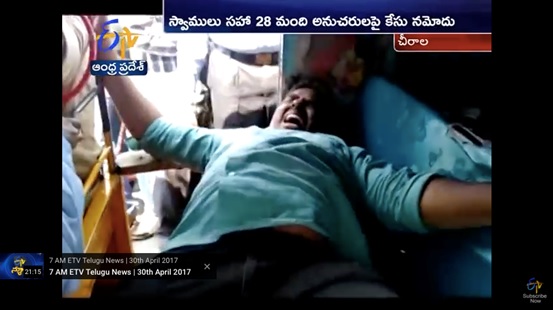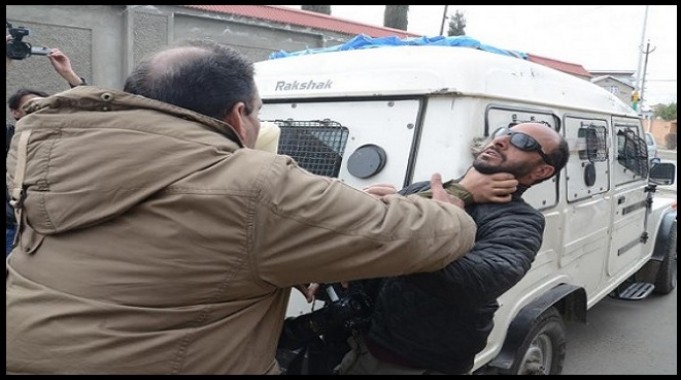The India Freedom Report, January 2016-April 2017
AFP photographer Tauseef Mustafa being assaulted by a policeman. Photo credit: Faisal Khan
THE INDIA FREEDOM REPORT

JOURNALISTS UNDER ATTACK
NEWS CENSORSHIP
DIGITAL CENSORSHIP
FREE SPEECH AND THE COURTS
DILUTING THE RIGHT TO INFORMATION
INTERNET SHUTDOWNS
CENSORSHIP OF THE ARTS
Over the last 16 months, issues of press freedom, freedom of expression, online freedom and personal freedoms have come together to produce an overall sense of shrinking liberty not experienced in recent years. On the occasion of World Press
Freedom Day 2017 it becomes important to view the level of press freedom in India in the wider context of societal freedom. The press cannot be truly free when facilitating freedoms such as the Right to Information and the Right to Internet, and the freedom of expression of the creative community, are shrinking.
JOURNALISTS UNDER ATTACK

The journalist assaulted in Chirala. ETV video grab, YouTube.
In the period being reported on, 54 attacks on journalists in India were reported in the media, according to the Hoot’s compilation. The actual number will certainly be bigger, because last week Minister of State for Home Affairs Hansraj Ahir said during question hour in the Lok Sabha that 142 attacks on journalists took place between 2014-15.
Though seven journalists were killed, reasonable evidence of their journalism being the motive for the murder is available only in one case.
The stories behind each of the attacks reveal a clear and persistent pattern. Investigative reporting is becoming increasingly dangerous. Journalists who venture out into the field to investigate any story, be it sand mining, stone quarrying, illegal construction, police brutality, medical negligence, an eviction drive, election campaigns, or civic administration corruption, are under attack.
Leave alone going out into the field, those who host chat shows in the relative safety of a television studio or voice opinions on social media networks are also subjected to menacing threats, stalking and doxing.
The perpetrators, as the narratives of these cases clearly indicate, are politicians, vigilante groups, police and security forces, lawyers (apart from the Patiala House court incident in Delhi in the wake of the JNU protests, there were a spate of attacks by lawyers in Kerala), jittery Bollywood heroes and, increasingly, mafias or criminal gangs that operate in illegal trades and mining, often under the protection of local politicians and with the knowledge of local law enforcing agencies. Hence, even with clear accusations of the identities of the perpetrators, they get away scot-free.
The data with The Hoot shows that law-makers and law-enforcers are the prime culprits in the attacks and threats on the media.
54 ATTACKS
|
PERPETRATORS |
NO. OF INCIDENTS |
|
Drug peddlers |
1 |
|
Actors and their bodyguards; film crew |
2 |
|
ABVP members |
3 |
|
Illegal construction industry |
3 |
|
Unconfirmed motives |
3 |
|
Liquor mafia |
2 |
|
Gujarat riot convict Suresh Chhara |
3 |
|
Police |
9 |
|
Officials accused of corruption |
2 |
|
Political party leaders/supporters |
8 |
|
Lawyers |
4 |
|
Cow vigilantes |
1 |
|
Army/Paramilitary security forces |
2 |
|
Illegal sand mining |
1 |
|
Doctors/interns |
1 |
|
Mob resisting/protesting media coverage |
9 |
|
Students |
2 |
|
Illegal coal mining |
1 |
25 THREATS TO JOURNALISTS
|
PERPETRATORS |
NO. OF INCIDENTS |
|
Politicians/political party members |
6 |
|
Mining Mafia |
2 |
|
Militant groups |
1 |
|
Police |
4 |
|
Vigilante groups |
2 |
|
Twitter trolls |
5 |
|
ABVP |
1 |
|
Lawyers |
3 |
|
UIDAI |
1 |
Details of attacks and threats
NEWS CENSORSHIP
1. Governments at various levels attempt censorship, so do private sector media owners. In the period under review there were a few striking examples of media censorship, of holding back news, and of self censorship.
2. In June 2016 the Andhra Pradesh government got cable operators across the state to block Sakshi News and No 1 news channels, on account of their coverage of the Kapu agitation. The leader of the numerically dominant Kapus, Mudragada Padmanabham, a former minister, started an indefinite fast in support of his demands, triggering a tense situation in coastal AP. Sakshi TV channel, owned by Jagan Reddy of the YSR Congress Party, lapped up these developments whereas other media houses reacted very cautiously. Then suddenly Sakshi suddenly went off the air. The Sakshi Media Group said their channel was blocked in the state.
3. After the killing of Burhan Wani, the Kashmir media experienced censorship and harassment. In July the offices of the two largest newspapers were raided, their copies seized, and their printing presses closed down.
4. In August a criminal complaint for inciting hate against different ethnic groups was lodged against independent Indian journalist, Neha Dixit, as well as Indranil Roy and Krishna Prasad, the publisher and editor of Outlook magazine for the journalistic exposé Operation #BabyLift, they had published in Outlook magazine on July 29, 2016. The complainants were an assistant solicitor general of the government of India at the Gauhati High Court, and a spokesman for the BJP.
5. In October the Kashmir Reader which did a lot of reporting from the ground found itself banned for a period which finally extended to three months. Its editor described here why it incurred the displeasure of the state.
6. In November a ban was imposed on NDTV India by the Ministry of Information and Broadcasting for a 24 hour period for its Pathankot coverage which is supposed to have revealed strategic information about the operation. The channel moved the Supreme Court against the ban. (See the section in this report on Free Speech and the Courts.) The Ministry put the ban on hold.
7. When Tamil Nadu chief minister Jayalalitha Jayaram passed away in December confirmation of the news was suppressed for seven hours by the hospital authorities, though TV channels were reporting her death from fairly early in the evening.
8. In March 2017 Member of Parliament and businessman Rajeev Chandrasekhar got a Bangalore court to issue an ex parte injunction to The Wire to take down two articles about him. This was curious because the website was not the first to point a finger at him for attempting to align the media he owns with the political ideology he supports. Nor was it the first to describe his military-related business interests, even as his public activism has centered on the armed forces.
Download the complete report here:
http://www.thehoot.org/public/uploads/filemanager/media/THE-INDIA-FREEDOM-REPORT.pdf
